The total number of business and consumer emails sent and received per day will exceed 306 billion in 2020, and is forecast to grow to over 361 billion by year-end 2024.
Yes, that’s billions. And yes, that’s per day.
You’re probably fighting the urge to refresh your own inbox right now (it’s ok, I am too).
There’s no arguing that email is an incredibly important part of today’s advertising landscape.
But, with so many emails floating around, it’s important to have some fundamental knowledge about the platform before jumping in head-first for your brand.
Subscribe to our weekly newsletter for tips so good that we might put ourselves out of business.
What is email marketing and why should I do it?
Email marketing is the act of communicating a commercial message through email.
The number of emails sent per day prove why it’s a marketing channel you can’t ignore, but the most attractive quality about email marketing is the ability to own your contacts. As long as you’ve received proper consent to email those people (more on that later), you have the power to market to them whenever you want and guarantee that your message makes it to their inbox. Unless you’ve totally abused email and ruined your sender score (again, more on that later).
On top of that, the potential ROI is huge, especially when compared to other digital marketing.
For every dollar brands invest in email marketing, they receive 42 dollars in return.
The profitability of the channel is due in big part to being so cost-effective. Email marketing software like Mailchimp have free plans and basic options starting as low as $10/month. For that $10/month pricing, you can still get access to powerful tools that help your brand cover many effective aspects of email marketing.
Even with some of the biggest email providers like Constant Contact, Hubspot or Zoho which provide marketing automation and customer relationship management (CRM) as well, the costs can still come in lower than what it takes to power a lot of other digital marketing efforts.
Email marketing is worth giving a serious attempt no matter your industry, size or location, no matter whether you’re running a small business or a growing startup, ecommerce business or non-profit. However, the “how you do it” can greatly depend on those details. There is no exact one-size-fits-all approach on how to do it, but I’ve put together 10 fundamentals that stand true in every situation.
Ok, go refresh your inbox real quick, but come right back!
10 Things You Must Know Before Beginning Email Marketing
1. Proper consent laws
The EU’s General Data Protection Regulation (GDPR) and the California Consumer Privacy Act (CCPA) are cracking down hard on privacy laws—and for good reason.
They are fighting to protect the privacy of each person’s information. Under new laws set by the GDPR and CCPA in 2019 and 2020, email users have the right to know how you obtained their personal information, how you use it, whether you sell or share it and who can access it. Most importantly, they also give email users the legal right to ask you to delete their information from your records.
Violating these rules can get costly. Among the biggest violators of 2019, the GDPR, fined Google for $57 million, British Airways for $230 million and Marriot for $123 million.
These laws are not something to be taken lightly, but they can be tricky to figure out. We’ve broken down everything you need to know.
You can avoid legal problems by providing a crystal clear opt-in process so that people know exactly when they’re signing up for your email newsletters and what they’re signing up for.
A clear opt-in method increases trust by 10%, while cheap shortcuts, such as using third-party lists and data vendors, actually decrease trust by 10%.
When in doubt, use a double opt-in method to confirm subscribers before adding them to your email list. A double opt-in will follow up their initial request with a confirmation directly to the email that the person signed up with that includes a second link to click. Only after that second link is clicked will that person be added as an email marketing contact.
The double opt-in safeguards your brand from getting an excess of things like spam reports and invalid emails resulting in bounced or undeliverable emails—both of which will ruin your email sender reputation. Internet Service Providers use your email sender reputation to decide if they’ll deliver your email or where to send it. A low score puts you at risk of getting sent to the spam folder or even completely denied.
Permission matters. Brands that rely on double opt-in see an ROI that’s 13% higher than that of brands that primarily use single opt-in.
As long as you’re following the laws, your scores will remain healthy. The scoring is designed to identify those who are abusing an email list by purchasing emails, sending irrelevant content, or emailing an aggressive amount.
Pro tip: make sure every email gives subscribers the option to unsubscribe. The unsubscribe option should be clearly visible and easy to use. Avoid having to make people sign in to change their preferences or go through multiple steps and questions. Nobody likes a messy breakup, especially the GDPR and CCPA.
2. Clarity and transparency is best
Transparency can go a long way in email marketing, especially in the beginning stages. Not only do people need to know when they’re being signed up for your email marketing, but they need to know what they’re signing up for.
It’s one thing to sign up for a newsletter you get monthly, but it’s a whole other ball game to sign up for a newsletter that you get every single day.
Along with being clear about how often you’re showing up in their inbox, it’s critical that you be clear about what they can expect. This line of thinking not only helps the prospective subscriber, but benefits your brand as well to force you to keep thinking value-first.
A helpful exercise you can do to get your brain thinking this way, is to try telling a friend to subscribe. If they’re an honest friend, they might laugh at you for suggesting adding yet another email to their inbox. But if they don’t, that’s also a good friend too because they’ll clearly go great lengths to support you and deserve kudos for that.
Hopefully they’ll challenge you and ask why they should subscribe which will force you to think on your feet about what they have to gain.
If you can’t give your friend a good reason to subscribe...you’ve got a big problem. More on that later.
There are a few areas where you can get your email relationship started off in a way that’s clear and transparent:
- In description of the email sign up on a pop up or landing page
- In the welcome email to new subscribers or new customers
- In the email signup form itself. If you want to get more sophisticated you can allow subscribers to choose a cadence they’re comfortable with and even which types of emails they want to receive before signing up.
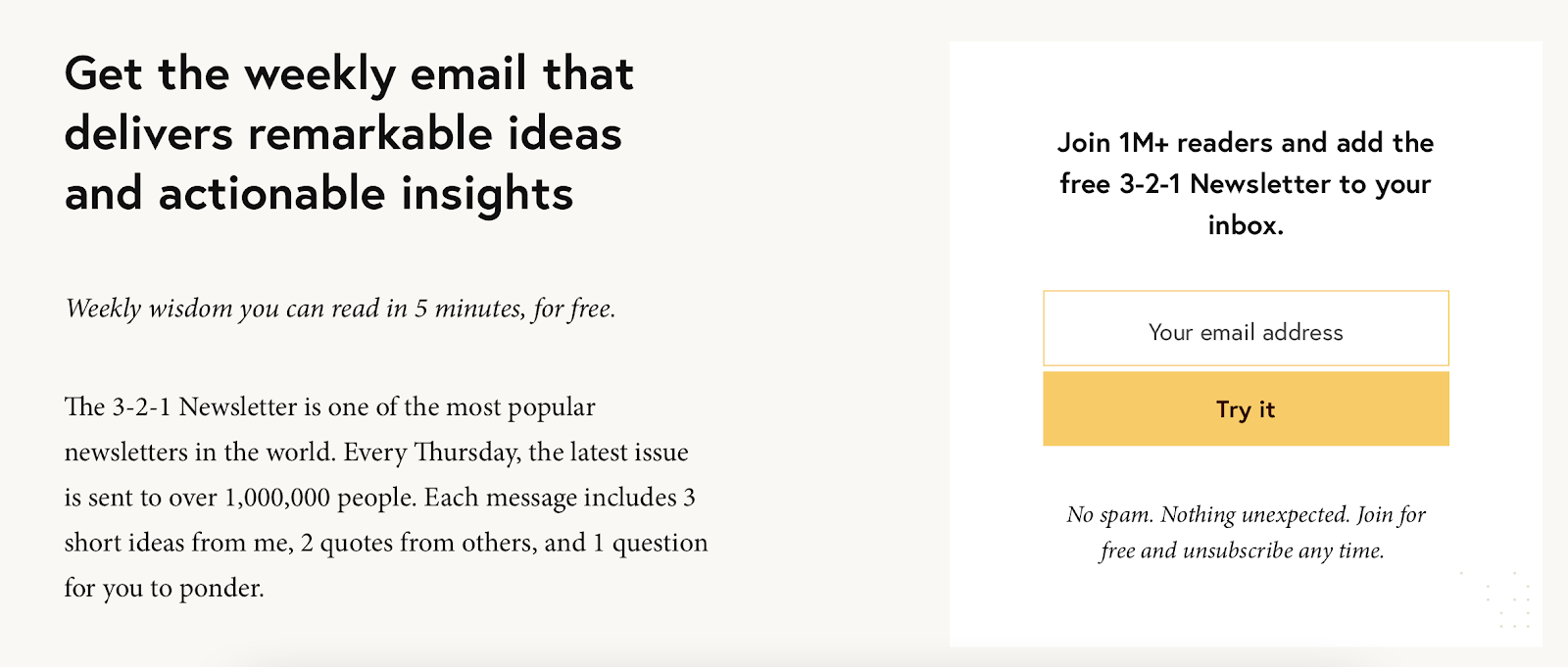
Atomic Habits writer, James Clear really nails this concept when asking users to join his 3-2-1 Newsletter. He covers the why, what and when so that prospective subscribers know exactly what to expect.
3. Quality > Quantity
Imagine that you’re granted a gift! Yay! You have two gift options. You can either get an email list of 100,000(!!!) people. OR you can get the gift of a 50,000 people email list.
You gravitate towards 100,000.
Here’s the catch. The list with 100,000 people averages a 9% Open Rate. The list with 50,000 people averages a really healthy 35% Open Rate.
That 100,000 person list seemed really enticing-at first. But in reality, it’s composed of maybe 9,000 engaged users. Whereas the 50,000 person list has 17,500 people actively engaging!
The size of your email list doesn’t mean anything, if it’s full of unengaged subscribers. Take the very thoughtful gift of 50,000 (properly consented) emails and run.
The best mindset you can have when it comes to email marketing is quality over quantity.
Luckily, the marketing industry is heading that direction, too. Progressive organizations are getting off “the MQL treadmill” and are focusing less on lead quantity and more on quality.
This means focusing less on vanity metrics such as size and more on the metrics that show the true health of your following (more on KPIs later).
If you’re just starting out, know that you don’t need a large following to do email marketing. Heck, even ten subscribers is a great place to start. Nobody is going to tell that one of those ten subscribers is your mom. You know she’ll open every single email and click every CTA, it’ll be great. Your secret is safe with us.
4. Value over everything
You’re setting yourself up for failure if you think you only need to send an email when you have an announcement. Effective email marketing has the ability to form a relationship by regularly showing up in an inbox AND providing value.
Don’t be that friend that only shows up when they need a favor. You want to have a regular presence in their inbox so your brand becomes recognizable, reliable, trusted and top of mind.
While I highly discourage emailing if you have nothing good to say...think of something good to say! There’s a lot of value you can provide.
This is going to take a lot of work and it won’t be easy, but it’s going to establish a really solid trust foundation. This reliability and trustworthiness establishes the type of foundation that leads to customer loyalty and brand fanatics.
Repeatable value can be provided in a multitude of ways. Some of my favorites are
- Using User Generated Content (UGC) from social media to show what others are doing
- Customer story campaigns to create community
- Providing a breakdown of industry news
- Sharing inspirational content
- Success story campaigns
- Providing expert thought leadership
- Helping others learn by offering an e-book or a toolkit
- Giving stuff away! Maybe it’s a company swag or a nice Visa Gift card
- Discounts, promotions or special offers
- Tips and tricks on how to use a product
The value can feature your products without selling. One of my favorite examples is beauty brand, Cocokind. Rather than throwing out their empty bottles, the team found practical ways to reuse them.
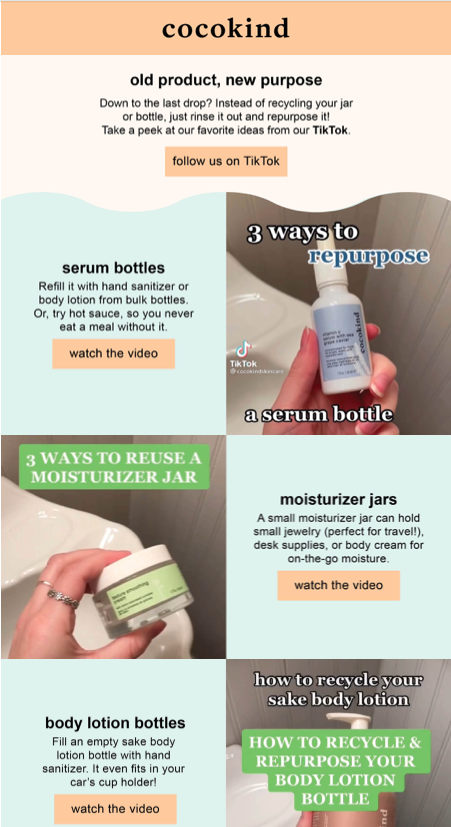
Pro tip: If you’re not already using this mindset when marketing, it can help across ALL channels. As you can see Cocokind repurposes this content on social media as well.
Value-first thinking is where you get all the great reasons to tell your friend to sign up and eventually your prospective email subscribers.
To get inspired think about your favorite emails. Why do you love them? Why would you suggest a friend also sign up?
5. Conversations > Campaigns
As a consumer, it can be really easy to forget that brands are made up of people too when they’re just shoving promos in your inbox or pushing you down the sales funnel. Email marketing gives an opportunity to show that your brand is made up of real people.
People want to hear from people, not brands.
More importantly, people want to be treated like individual people. They want to know that you care about them, what they think and their experience.
84% of consumers say being treated like a person is very important to winning their business.
A few examples of ways to show the people behind the email and get your email subscribers to use that reply button for some 1:1 quality time:
- Embrace personality. Don’t be a robot and don’t take yourself so seriously. (Even transactional emails or calls-to-action can be fun)
- Ask questions! Such as what made you sign up? What problems are you having? What product feature do you want to see next?
- Add the sender’s name in addition to the company name in the “from” section. Ex: Jane at Really Cool Company
- Add a personal note at the top or bottom of the email with a small photo
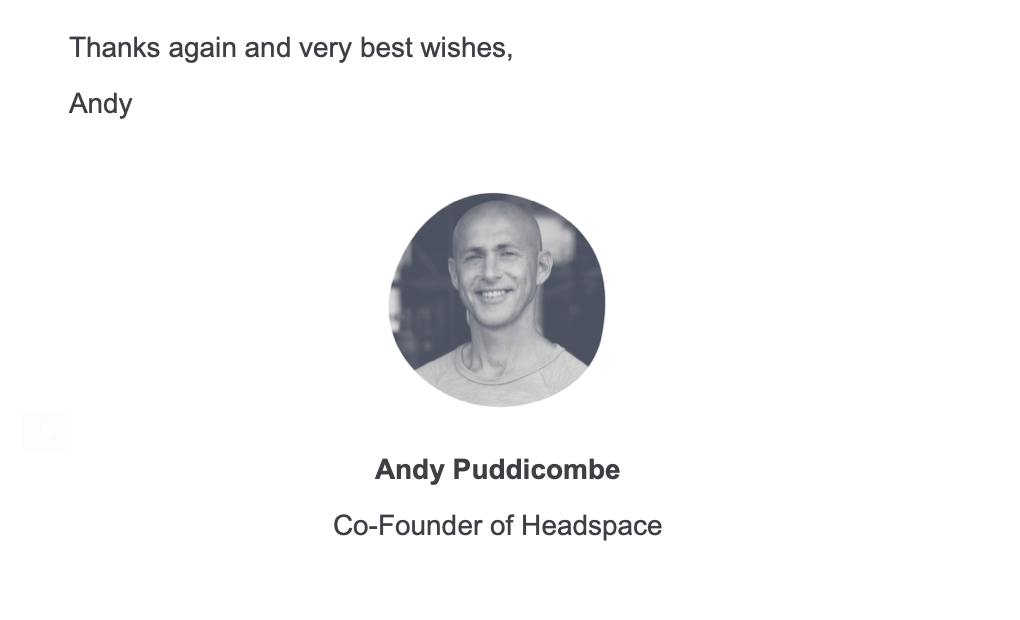
Pro tip: you can get even more of a response from subscribers when you ask questions that don’t require them to think or type up a paragraph. Let’s say you want to get feedback on a new product feature for example. Rather than leave it open-ended, give them a couple options of what you’re thinking so they can hit copy, paste and reply.
6. Segmentation & Personalization
Customers are now savvier and less tolerant of these brand-centric messages and are demanding more meaningful, relevant and personalized experiences from email marketers.
55% of consumers like messages that have personalization to include products and offers that match a person’s preferences.
Even the most basic email service providers are allowing for opportunities to personalize your emails such as using a subscriber’s name or company. Beyond the basics, email service providers are always collecting data on which emails have been opened and which links have been clicked. All this information is at your disposal to make messages hyper-relevant.
I can personally attest to the success of these techniques.

While learning about The Farmer’s Dog, a dog food company, they asked me for my four-legged friend’s name, breed and size to give my pup a custom meal plan. After delivering the custom meal plan promised, they’ve used this information to personalize all my follow up emails. It catches my attention every single time. Fair warning though, I am obsessed with my dog, so I realize my opinion here might be biased.
However, even according to the surveys, personalizing email subject lines alone can lead to higher open rates—as high as 50%!
The best personalization is a result of segmentation. Segmentation is the practice of breaking your subscribers into groups that allow you to target them with messages that they will find relevant.
There are a multitude of ways to segment your audience depending on the type of business and information captured.
A good example would be a phone accessory company. You’re going to segment your subscribers based on their website activity and past purchases so that you’re not blasting iPhone users with the latest Android case. Not only are iPhone users not interested in Android products, but let’s be real, you’re either Team Apple or Team Android and some people take that pretty seriously.
Another way to get this segmentation is through your email opt-in form. If you’re B2B you can ask for information such as company size, industry or title. If you’re B2C you can have them select interests such as mens or womens, promos or new releases, product updates or just promotions.
Marketers who use segmented campaigns note as much as a 760% increase in revenue. (Campaign Monitor, 2019).
Some of the most popular information used to segment B2B audiences:
- Company position
- Revenue
- Company location
- Industry
- Past Email Activity
- Past Website Activity
- Subscription Status
Some of the most popular information used to segment B2C audiences:
- Gender
- Age
- Location
- Past Email Activity
- Past Website Activity
- Past Purchases from your online store or physical location (sometimes even by how much they’ve spent)
7. Email Design isn’t everything
There’s a big asterisk to this one. Note that I am NOT saying that design shouldn’t be part of your email marketing strategy. It does matter.
But let’s consider the facts.
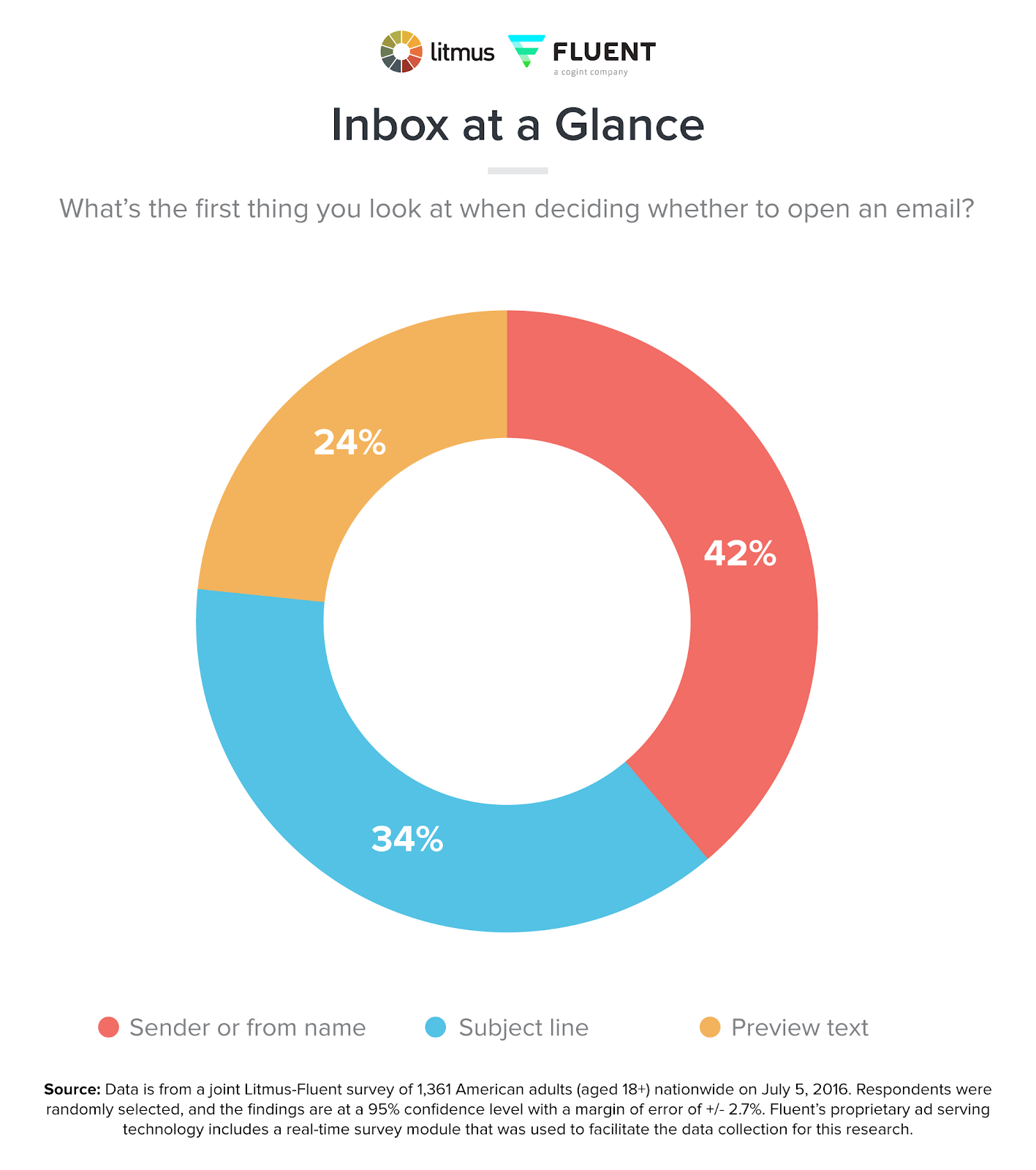
The from name, subject line and preview text are the 3 most important parts of your email. So your design won’t matter if people don’t even stop to open it! The messaging of email is truly the most important part. From the subject line to the body copy.
With that said, the basic design of the email is something you want to think about and get right. Making sure that things are spelled right, clearly linked and there’s some kind of visual hierarchy for the eye to follow. Visual hierarchy can be accomplished by using headlines, bold section headers, lists, consistent copy formatting and even spacing.
The TL;DR here is that, you don’t need a fancy design to have a kickass email.
Even if your design is top-tier, it won’t necessarily matter if the content doesn’t resonate.
I’ll also add that you can have a super fancy design that can actually *distract* the reader from the message. When you’re looking for email templates, keep that in mind so you can find the perfect balance.
One of the best examples of a company who doesn’t use fancy design (when they totally could) is actually an email service provider, Autopilot. Their newsletter comes from their CEO, Michael Sharkey who relies on excellently written copy.
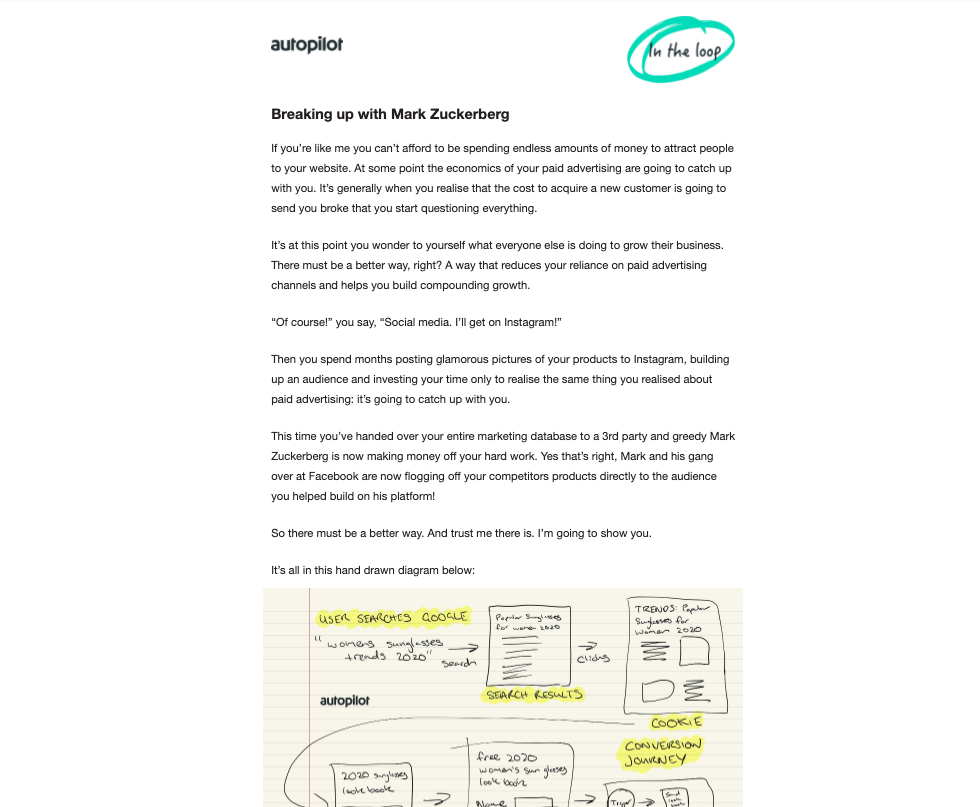
He captures you with a very compelling subject line and opening copy followed by thought leadership and valuable insights to keep you reading all the way through. No fancy design, just some hand drawn scribbles.
You can do what Andy can do too by learning more about content marketing and reading through some of our favorite examples.
Pro-tip: make sure your designs and font sizes are legible on mobile devices. 60% of email opens are from mobile devices. Better yet, check to see if your email marketing service offers responsive email templates that will adjust your email to best fit the device it’s being viewed on.
8. Do a Spring (Summer, Fall, Autumn and Winter) cleaning
Sometimes you’ll do everything we’ve mentioned above and there will still sadly be people who don’t open your emails.
Let it go.
The most important thing you could do to keep an ultra healthy subscriber list is to continually clean out the subscribers that are weighing your metrics down.
If a subscriber has not opened or clicked an email in months, clear them out.
That doesn’t mean you can’t give these people a good last fight. You can do this by sending them a last chance email that contains all your best content and communicates a clear reason they should start opening your emails again before getting rid of them. Try to capture their attention by using a catchy subject line like “Are we breaking up?” or “Is this the end?”
I recommended sending out these last chance email marketing campaigns once a year at the minimum, however once a quarter will yield the best results.
It’s hard to part ways with a chunk of your hard-earned subscriber list, but there’s more fish in the sea.
As you evaluate how you’ll manage your emails be sure to check out their offerings. Many email marketing tools will allow you to automate this process. It’s not uncommon for marketing automation and email services to be combined in one tool.
9. Familiarize yourself with KPIs
You’re well on your way to creating effective email campaigns, but to truly be set up for success you have to be prepared to keep track of the right results and know how much value your email marketing efforts are bringing your brand. Ultimately, these metrics will help you make better decisions and determine how much investment to make when it comes to email marketing.
Some of the most important metrics you want to track to indicate the quality of your email marketing campaigns are:
- Open rate - how many subscribers opened your email
- An indication of how well your from name and subject line is as well as your email deliverability, which is your brand’s ability to make it past the spam folder essentially.
- The average email open rate is 22.02% .
- Click rate - how many subscribers clicked a link within your email
- An indication of how many subscribers are taking an action that you want them to take.
- The average click-through rate is 2.13%.
- Click-to-open rate - of the people that opened your email, how many clicked a link
- An indication of how many of those people who opened your email, found something relevant and valuable.
- The average click-to-open rate is 10.12%.
- Unsubscribe rate
- An indication of how many people are opt-ing out of your email.
- The average unsubscribe rate is 0.12%.
The averages above are very broad and can differ greatly by industry and region. Find a better benchmark for your industry and by using GetResponse’s industry averages breakdown.
Some examples of data you’ll want to track that can help calculate the ROI of your email marketing are:
- List Growth Rate
- Purchases
- Website Traffic
- Conversion Rates
To track these you’ll want to be sure to set up your Google analytics, the events or actions you want to measure as well as use proper link tracking. As soon as you’re set up to track, you can boil these metrics down to an exact science to get the higher conversion rates you’ve been looking for.
10. A/B Testing
As I said in the beginning, there is no one-size-fits-all approach. What works for one brand or industry might totally fail for yours. In order to find the best email marketing strategies for you, you have to keep testing.
Be sure to effectively A/B test by only testing one piece at a time.
From your subject lines, to your designs, to the time you send it out. Narrowing down these details to find what works best is going to get you the highest ROI possible.
Brands that always include an A/B test in their emails generate an ROI of 48:1.
Testing is especially helpful when it comes to email because you can get really clear results from your email marketing campaigns instantly. Whereas with things like social media or SEO, it’s extremely hard to get 100% accurate results because the same people won’t see the same post or article.
Before you click send
Take advantage of all the different types of emails you can send. Email doesn’t have to be boring or robotic. There’s so much opportunity and so much to gain from this channel when used strategically.
If you’re looking for some more inspo of successful email marketing check out a whole variety of creative emails from ecommerce to nonprofit to schools and more at Really Good Emails.
The optimization efforts and marketing tips that you take away from email will ultimately help you with all your digital marketing efforts as well. Email is only part of the equation. The results you build within email can benefit everything from social media, to SEO, to sales.
Now you can go back to refreshing your inbox, but hopefully this time you’re looking at it through a whole new lens.